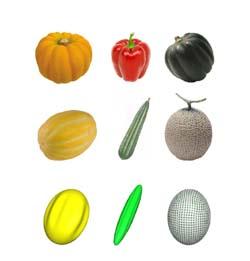
Groovy Fruit: grown and simulated.
Pumpkins, melons, bell peppers, gourds, cantaloupes and many other fruit and vegetables have skins with ribs and ridges, of which the complexity in the formation could "drive the sanest man mad" according to Charles Darwin. Prof. CAO Zexian at Beijing National Laboratory of Condensed Matter Physics, CAS Institute of Physics (IoP), in cooperation with Prof. LI Chaorong at Zhejiang Sci-Tech University and a research group headed by Prof. CHEN Xi from the Columbia University, US, have taken these fruit and vegetables from the kitchen to the laboratory for a thoughtful experimental and numerical simulation. As a result, a simple, universal reason for these patterns has been established.
Since 2004, Cao and Li (also with IoP at that time) have been devoted to the study of stress-driven self-assembly on nonplanar surfaces, revealing that stress-driven buckling modes are closely related with the geometric properties of the supporting surfaces. They successfully coaxed, via stress engineering, the stressed points on the Ag Core/SiO2 shell microstructures to self-assemble into the triangular tessellation and Fibonacci parastichous spirals in 2005, and reproduced a few groups of Fibonacci spirals (3 by 5 through 13 by 21, and in both sinister and dexter forms) in laboratory in 2007.
For a long time Prof. Cao and Prof. Li realized that the fruit with their navels and ends as the two antipodes can be simulated by a spheroid. And recently, the simulation performed by Prof. Chen Xi's group, by using the finite element method with software ABAQUS, has justified their conception that various fruit patterns have been reproduced as the buckling modes of the stressed spheroidal surface. The results showed that the diversified pattern deformations like ribs, ridges, reticula and dimples appear on the spheroid models and they are mainly governed by three dimensionless parameters: the effective thickness of the shell (ratio of the shell thickness to the size), the level of overstress, and the shape factor of the spheoids -- whether it is elongated (like a cucumber) or flattened (like a pumpkin). It is found that a particular pattern appears in a definite domain in the parameter space. This adds more evidence to the conjecture -- it can be dated back to 1904 or even earlier to some British scientists -- that the appearance of some natural fruit and vegetables may be merely a result of stress-driven buckling, a mechanical principle, rather than genetic force.
Their research paper entitled "Stress-driven buckling patterns in spheroidal core/shell structures" was published in the 17 November issue of the Proceedings of National Academy of Sciences . The research, which received support from the National Natural Sciences Foundation of China and China's civil space projects, provided the first explanation of how the appearances of the natural plants and fruit are affected by mechanical principles, raising a new perspective for understanding the morphological diversity in the living world.





